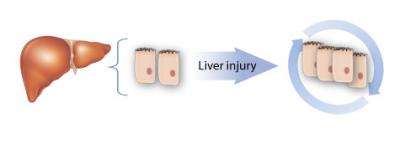Researchers find molecular switch turning on self-renewal of liver damage

The liver is one of the few organs in our body that can regenerate itself, but how it occurs is a biological mystery. New research from BRIC, University of Copenhagen and the Finsen Laboratory, Rigshospitalet, has identified a protein complex that acts as a molecular switch turning on a self-regeneration program in the liver. The protein complex furthermore fine tunes liver metabolism, allowing this to run efficiently in parallel with the tissue damage repair. The new knowledge challenges the current focus on stem cells and may point towards future simplification of treatments used for repairing tissue damage.
"Our new data challenge the predominant 'stem cell-mania' as the results reveal important molecular mechanisms that enable ordinary liver cells to divide and repair tissue damage. This may point to ways of using ordinary liver cells for therapeutic purposes, as these cells may be easier to use than stem cells," says Head of Clinic and Professor Bo Porse who has lead the investigation.
Turning on self-renewal genes
When the specialised cell types of our body are formed from stem cells during development, they generally lose the ability to divide and make new cells. Tissue renewal is therefore a job for the stem cells present in our body. One exception is the specialised cells of the liver called hepatocytes. They are responsible for the metabolic functions of the liver, but can at the same time produce new liver cells. How that is possible is a bit of a mystery.
"Our results show how a protein complex is changed upon damage to the liver, making it function as a 'switch' turning on a self-renewal program in the hepatocytes. The protein complex literally turns on selected genes that enable division of the hepatocytes, while maintaining their metabolic functions," says postdoc Janus Schou Jakobsen, who has lead the experimental part of the investigation.
The extraordinary ability of the liver cells to divide almost indefinitely resembles the ability of stem cells to self-renew and this finding challenges the current focus on stem cells and stem cell therapy.
Self-renewal programs in non-stem cells
The new results from Bo Porse's research group are consistent with new studies of self-renewal in the group of white blood cells called macrophages.
"We see a clear overlap in the molecular mechanisms controlling self-renewal in hepatocytes and macrophages and that could indicate the existence of a more general self-renewal program used by specialised cell types. If this is the case, it can really change the current perception that only stem cells are responsible for renewal of our tissues," says Janus Schou Jakobsen.
The study addresses basic research questions, but if it can be shown that one can turn on and off specific sets of genes, making many types of specialised cells divide, it can have great impact on future regenerative treatments. It is very likely easier to make a specialised cell copy itself, than to extract the very scarce stem cells and accurately reprogram them to the specialised cell type of need.
Self-renewal and cancer development
The research in Bo Porse's laboratory focusses both on tissue renewal and on how mistakes in the genetic control mechanisms can give rise to cancer.
"Currently, so-called cancer stem cells receive much attention - these are single cancer cells that are difficult to kill. They have taken over stem cell programs enabling them to divide uncontrolled and to reform an entire tumour. It is likely that cancer cells can also hijack the self-renewal programs we have identified in liver cells. Increased knowledge on these self-renewal programs may therefore lead to a new understanding of cancer cell biology and open up for new treatment strategies," says Bo Porse.
The next step for the researchers is to dig deeper in the molecular understanding of how self-renewal systems can be turned on and off in specialised cell types.















